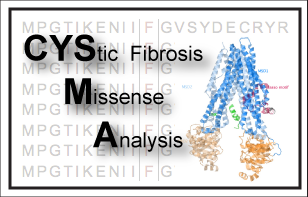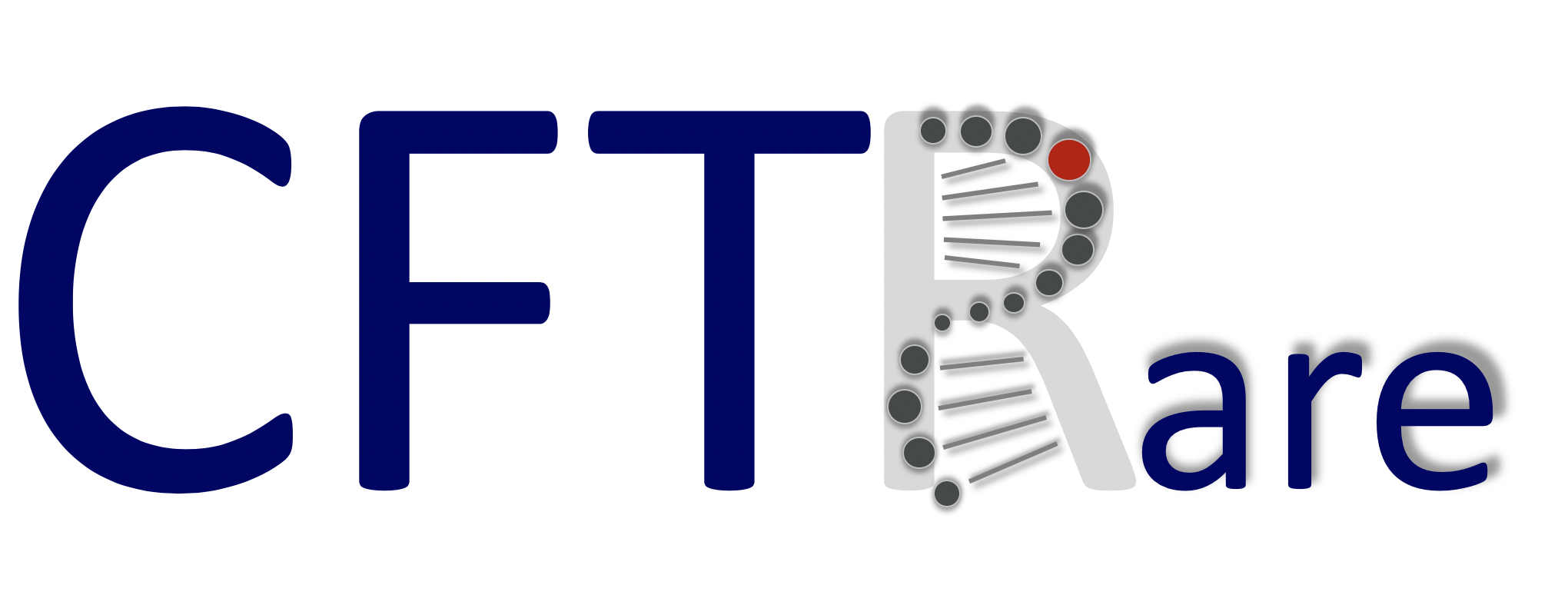About CYSMA
Alignment Average Percentage Identity
Residue's conservation is first assessed within a set of ortholog sequences.This multiple alignment is useful because it highlights the residues which have been maintained by evolution despite speciation. Indeed, the more the position is conserved, the more the variant is likely to have an impact on the protein function. CYSMA provides several features to help in interpretation:
- Alignment average percentage identity (AAPI), calculated with Bioperl, represents the vicinity of the different sequences of the set. Be careful with the non-mammals sequences, speciation arose a long time ago!
- Alignment average percentage identity of the region (AAPIR), calculated on 20 residues around the position of the variant (10 upstream and 10 downstream), can highlight highly or poorly conserved regions. AAPIR appears colored if its value is 10% greater or lower compared to AAPI.
- Number of sequences, and divergences. The more sequences the alignment contains, the more information you can extract. Divergences show the other amino acids which have been selected in the evolution
- If you find the mutant residue in the ortholog alignment, especially in a mammal species, be cautious, but your variant is very likely not to alter the protein structure (but don't forget splicing!).
- Conservation focuses on the wild-type residue, conservation - gap is the same figure, but here, the gaps are not taken into account.
- AAPIRs have been calculated for the whole alignments.
Divergencies: residues selected in the evolution
From the orthologous multiple sequence alignment, CYSMA identifies the divergencies, i.e. the amino acids, which have been selected and tolerated through the evolution. CYSMA shows if the residues share common properties (polarity, size...) with the wild-type or with the mutant residue.
- Venn diagram of the alignment. It shows physico-chemical properties of the different residues involved. Wild-type residue is shown in green, mutant in red (or purple if found in the alignment). The other residues are shown in orange if they appear in the alignment. Size of the letters depends on the presence in the alignment: the less the residue is found, the smaller the letter is. A star (*) character before a letter indicates an occurrence limited to no more than 5% in the alignment. The mutant residue is small and red if it has never been found in the alignment. If it is purple, it has been found and its size reflects its percentage in the alignment.
- a phylogenetic tree build with the orthologs alignment is also provided to help in interpretation.
Alignment Average Percentage Identity
- Alignment Average Percentage Identity of the Domain (AAPID), similar to AAPI but focused on the domain. Amino-acid positions are indicated.
- Alignment Average Percentage Identity of the Region (AAPIR), calculated on 20 residues around the position. This allows to highlight highly conserved domain regions. AAPIR appears colored if its value is 10% greater or lower compared to AAPID.
- Number of sequences, and divergences. In this case, as we often have a high number of sequences, you might find several alternative residues for each position. Residues present in more than 10% of sequences are highlighted in blue.
- Domain sequence alignment:can be downloaded and visualized using an alignment viewer such as Jalview.
Divergencies: residues selected in the evolution
From the homologous multiple sequence alignment, CYSMA also evaluates the residue's conservation and identifies the divergencies, i.e. the amino acids, which have been selected and tolerated through the evolution. CYSMA shows if the residues share common properties (polarity, size...) with the wild-type or with the mutant residue.
Venn diagram of the alignment shows physico-chemical properties of the different residues involved. See "ortholog conservation".Wild-type residue is shown in green, mutant in red (or purple if found in the alignment). The other residues are shown in orange if they appear in the alignment. Size of the letters depends on the presence in the alignment: the less the residue is found, the smaller the letter is. A star (*) character before a letter indicates an occurrence limited to no more than 5% in the alignment. The mutant residue is small and red if it has never been found in the alignment. If it is purple, it has been found and its size reflects its percentage in the alignment.
Predictions have been made with PsiPred, version 2.5. The output of the software is a "three-state" result, i.e. the residue is part of an α-helix, of a β-strand or none of these, and a probability associated to the predicted state. if the residue belongs to an helice or to a strand, "observed frequencies" of the wild-type and mutant residues in this state are displayed. These frequencies have been calculated on a set of 8,365 3D structures, representing 1,598,587 residues, extracted from a set of 14,550 non redondant (< 90% identity) structures. Annotated representative structures presenting a resolution < 2.5 Å have been taken into account, and helices of less or equal to 3 residues and strands of less or equal to 2 residues have been eliminated. Then, frequencies have been calculated on the basis of the pdb structure files annotations, following the Chou-Fasman(10) method of calculation. The graphs displayed below are a comparison of these results with those obtained by Chou and fasman in 1978(11) , Creighton in 1983(12), and more recently, by Costantini et al. in 2006 (using a set of 2,216 structures)(13).
When applicable, an analysis of the wild-type and of the mutant structure is performed by CYSMA. This section gives you access to predictions on the potential changes in the secondary structure (based on the 3D structures), to structural predictions calculated with the CYSMA's 3D Automatic Annotation pipeline and to the CYSMA's customized 3D visualizing module.
Secondary-structure features based on the 3D structures
CYSMA analyses specific secondary-structure features, especially in α helices, where specific propensities can be applied for N-cap, N1-3, interior, C3-C1 and C-cap positions of helices (see below for positions). Moreover, CYSMA checks for i,i+3 and i,i+4 possible interactions.

Figure - Positions of residues in α helices and possible side chain-side chain interactions: The N-cap residue is "the residue with non-helical φ, ψ angles immediately preceding the N-terminus of an α helix" (23). Then, N1, N2, N3 and N4 are the four first residues of the helix, designing the first turn. reciprocity gives C4, C3, C2 and C1 as the residues forming the last turn of a given helix, with C-cap the first non-helical residue right after an helix. A residue i will have its side-chain accessible for interaction with residues i+3 and i+4 mainly because these residues will be displayed on the same side of the helix. i,i+4 intercations are the strongest.
CYSMA's 3D Automatic Annotation
A first table presents a brief assessment of the 3D model, and a link to the complete MolProbity output is provided.
Then, CYSMA's Automatic Annotation pipeline is used to predict the impacts of the mutation on the CFTR structure and functions. The results are presented under in tables. These effects include modification of solvant accessibility, h-bond network, salt bridges network, hydrophobic cores, disulfide bridges and possible steric clashes.
WARNING! The experimental 3D structure used for our predictions is the human CFTR structure which have been solved at a 3.9 Å resolution using cryo-electron microscopy (PDB: 5UAK; Liu et al. 2017). The overall resolution is fairly low so the CYSMA's 3D Automatic Annotation pipeline might have missed some important structural effects. We recommend you to double-check with the CYSMA's 3D visualizing module, especially if your conclusion is mainly made out of the structures.
CYSMA's 3D visualizing module
Data and software developpement
CYSMA has been developed and is maintained in the Molecular Genetics Laboratory of University Hospital, Montpellier, EA7402 by Souphatta SASORITH, David BAUX, Corinne BAREIL, Anne BERGOUGNOUX and Caroline RAYNAL [IURC, Institut Universitaire de Recherche Clinique].The software has been built from an updated version of USMA, the Usher Syndrome Missense Analysis website.
Funding
The project is supported by the French Association "Vaincre la Mucoviscidose", which also funds the CFTR-France database.Citing CYSMA:
Sasorith S, Baux D, Bergougnoux A, Paulet D, Lahure A, Bareil C, Taulan-Cadars M, Roux AF, Koenig M, Claustres M, Raynal C. The CYSMA web server: an example of integrative tool for in silico analysis of missense variants identified in Mendelian disorders. Hum Mutat. 2019 Nov 1. doi: 10.1002/humu.23941. [Epub ahead of print] PMID: 31674704Atelier sur le Diagnostic Moléculaire de la Mucoviscidose (13-15 September 2018, Baillargues)
Postal address
Molecular Genetic Laboratory for rare diseases and EA7402IURC (Institut Universitaire de Recherche Clinique)
640 avenue du Doyen Gaston Giraud
34093 MONTPELLIER
FRANCE

